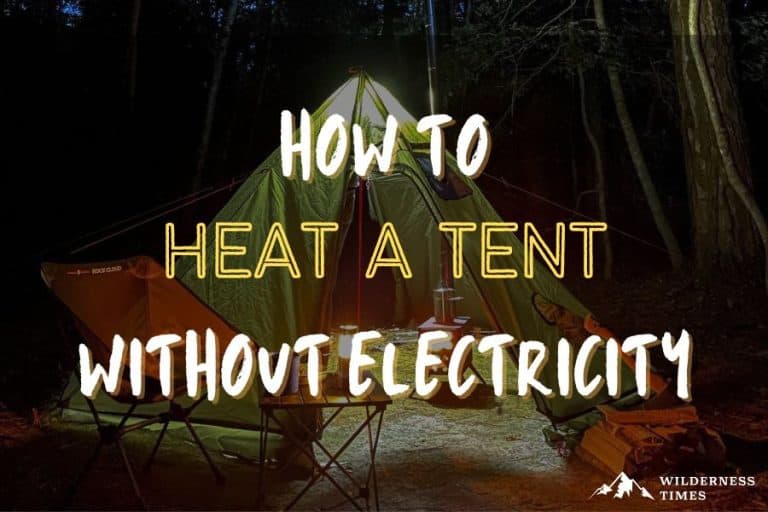Camping on a chilly night can be fun – as long as you can figure out a way to keep warm! But trying to heat a tent without electricity is tough.
When you’re camping out in remote areas, you need to think ahead about strategies for keeping your tent toasty warm.
In this article, we’ll go over some of the best methods for heating your tent without using electricity.
Staying Warm: The Basics
Before we jump into advanced strategies for keeping your tent warm without electricity, let’s go over some basics for staying warm.
Clothing & Personal Heat Retention
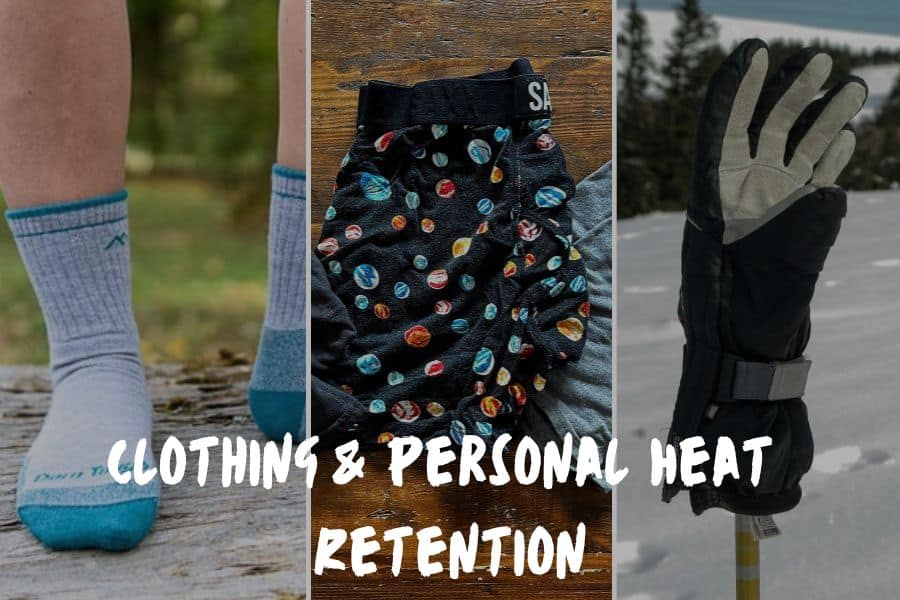
When you’re outside on cold days, it should be your priority to keep yourself warm.
The best way to do this is to wear proper gear and equipment.
Heat is concentrated in the core of your body, so keeping your core warm is vital.
The best way to do this is through insulated base layers, fleeces, and waterproof outer layers.
Long underwear made of moisture-wicking materials like wool or polyester is ideal.
Even if you end up sweating at some point, the fabric of your underwear will keep you warm even when damp.
Since your extremities, like your feet and hands, are away from your base, you’ll need specific gear like thick socks, gloves, etc. to keep them extra warm.
From there, you can add more layers to achieve better warmth.
In really cold temperatures, go with a light jacket or a sweater.
If you get too hot during the night, you can easily remove them.
Use Winter-Rated Sleeping Bag & Liners
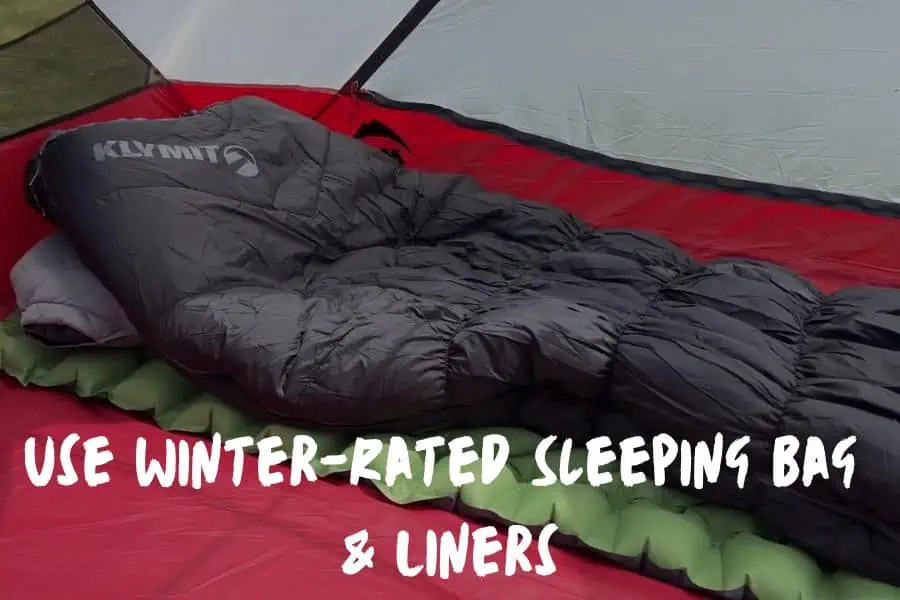
When camping in cold weather, it’s crucial to bring a winter-rated sleeping bag and liner that are built to keep you warm in the lower temperatures.
Sleeping Bags are one of the most important pieces of gear you can bring to keep yourself toasty on a cold night.
You could wear absolutely every piece of clothing you brought to your trip, but you won’t be warm without a proper sleeping bag.
Sleeping bags are rated via two systems: the European Norm (EN) or International Organization of Standardization (ISO).
These temperature levels fall roughly into three main categories:
- Warm-weather sleeping bags: 32°F and above (0°C and above)
- 3-season sleeping bags: 20 to 32°F (-6°C to 0°C)
- Cold-weather sleeping bags: 20°F and below (-6°C and below)
Depending on the severity of the cold you’re camping in, use your best judgment to pick the bag that’s right for you.
Sleeping liners provide an additional layer between you and the cold air, so they’re crucial in keeping you warm at night.
Most sleeping liners are scored on an “R” value, which measures their level of insulation capability.
This scoring framework ranges from 1 to 5.5+.
When camping in three seasons, pick a liner between 3-5 on r value.
If you’re going to be camping in especially frigid weather, go for 5.5 and above.
Keep in mind that the bottom of the sleeping bag is not as warm as the middle.
But keeping your feet warm is essential for having a comfortable sleep.
Wearing socks is a great way of adding more insulation to your feet, and merino wool is arguably the best material for this.
And during really cold nights, wearing a hat or a beanie while you sleep will keep your head warm.
Choose A Campsite With Wind Protection
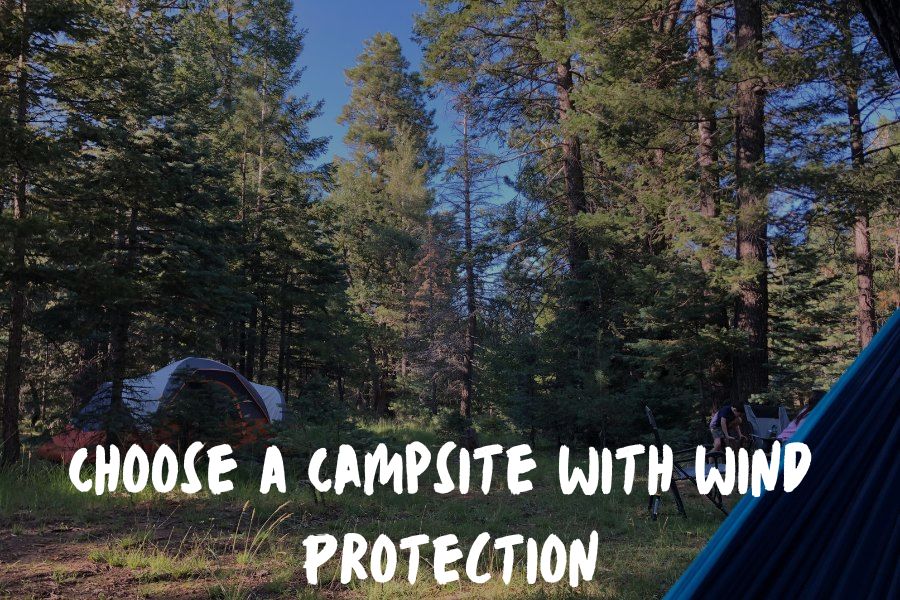
Choosing the best campsite can be just as important in keeping you warm as building a fire is.
The goal should be to stay away from places where you’ll be exposed to the wind, like the side of a mountain, or flat fields with no wind break.
To keep yourself protected from the wind, look out for natural windbreaks, like large rocks or sheltered knolls.
With that being said, you don’t want to place the tent directly under a tree or heavily surrounded by bushes.
During the day, they can block the sun, so your tent will be colder.
Choose The Right Tent
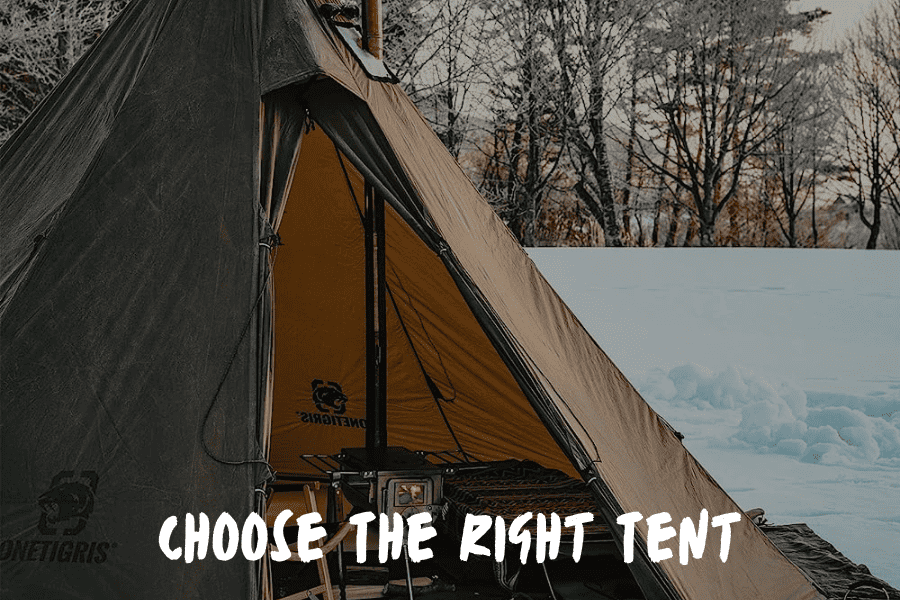
Most 3-season, double-walled tents will stand up fairly well to cold weather.
If you’re camping in especially frigid temperatures, you should spring for a 4-season tent.
These leverage their materials and designs to conserve heat and keep you extra warm.
You can also use a hot tent, which has an extended snow fly and interior space to fit a wood-burning heater.
Hot tents are treated to be flame resistant, so it’s safer to build a fire inside than with other tents
Note: A hot tent is the ONLY tent you should ever build a fire inside!
A Note On Safety
Some of the heating strategies listed below can be dangerous to you and your camping equipment, so it’s important to be careful.
First, a little chemistry. The majority of fuel-based heating systems use oxygen from the surrounding air to create heat.
That chemical reaction releases carbon dioxide as a product.
In cases where there isn’t enough oxygen in the air (like in a tent without proper ventilation), you risk there being too little oxygen.
If your heating technique does not have enough oxygen, it will instead give off carbon monoxide, an invisible and poisonous gas.
The main way to prevent carbon monoxide from building up is to ensure there is proper ventilation throughout your space.
This can be difficult to do in a cold situation, when you want to keep all the warmth concentrated inside your tent.
But it’s absolutely crucial to keep the lethal gas from building up.
When you’re using fire-based strategies, it’s important to remember that most camping equipment is flammable.
Especially things like down sleeping bags.
Prevent fires and equipment damage by ensuring that fires are a safe distance away and that hot items are wrapped in flame-resistant fabric.
So, keep yourself warm, but safe!
Also see: Is a Mr. Heater Buddy Safe in a Tent?
Safe Fuel-Based Heating Options
If you’re able to carry gas or kerosene with you to your campsite, these fuel-based heating options can be great additions to your cold-weather campsite.
Propane Heaters
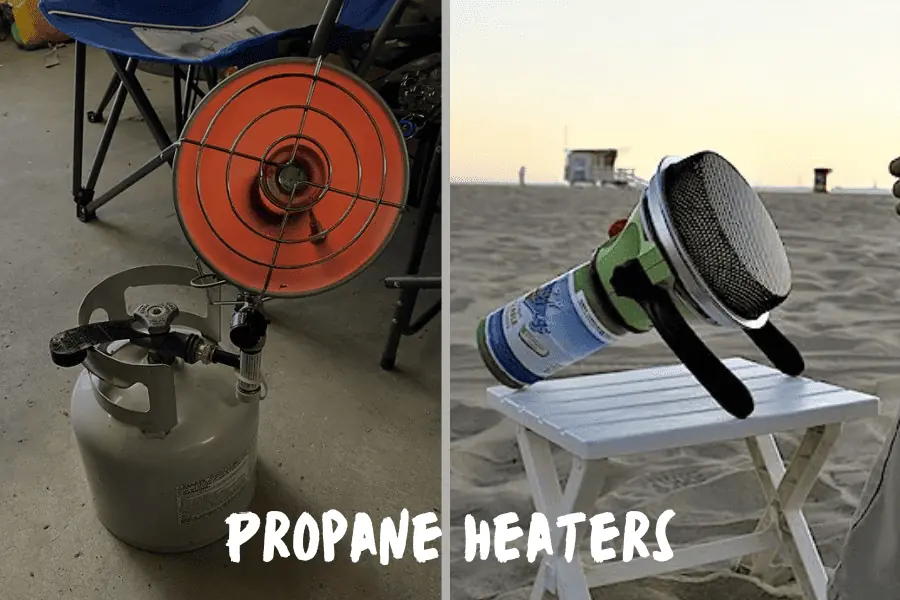
Heavy but effective, a propane heater consists of a heating “head” or tool that you will attach to a propane tank and use to heat the tent.
This type of heater is especially useful for heating large spaces but can be dangerous if it gets too close to your tent or sleeping materials.
Generally, propane heaters run on small, one-pound propane tanks.
But if you need to keep the heater on for many hours at a time, you can attach a larger tank by using an adapter.
The great thing about propane is that it’s sold in tanks of different sizes, so you can find the one most suitable for you.
Another great thing about propane is that it works in high altitudes and temperatures above -43.6°F.
That means your propane heater will work well in most conditions.
Read: Butane vs Propane vs Isobutane (Which is Best?)
Liquid Fuel Heaters
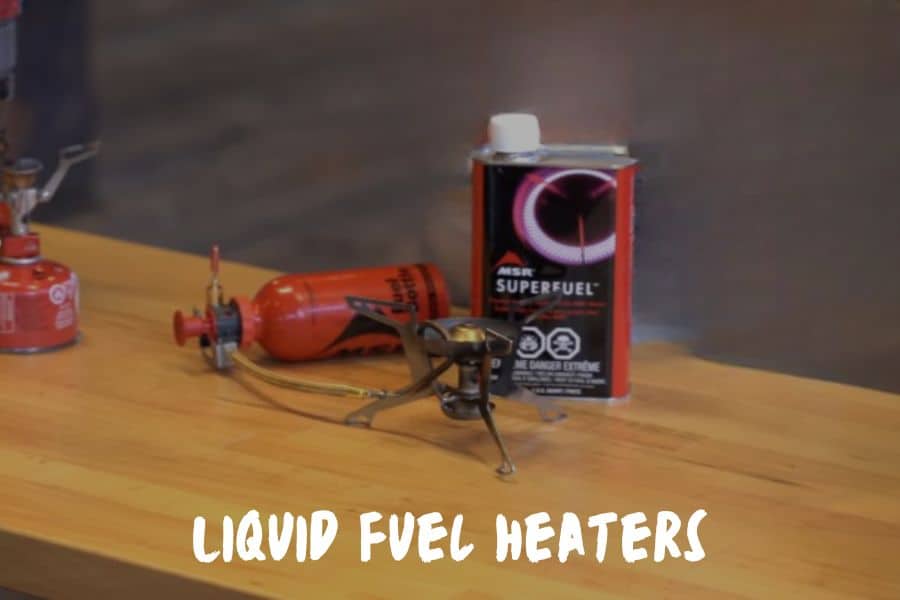
Liquid fuel heaters use kerosene to heat a surrounding compartment and warm the interior of your tent.
They can be hung or placed in the tent to keep it warm but can still be dangerous if left unattended.
This type of heater is not as bulky as the propane heater, although you will still need to carry fuel with you if you wish to use it.
Wood-Burning Stoves
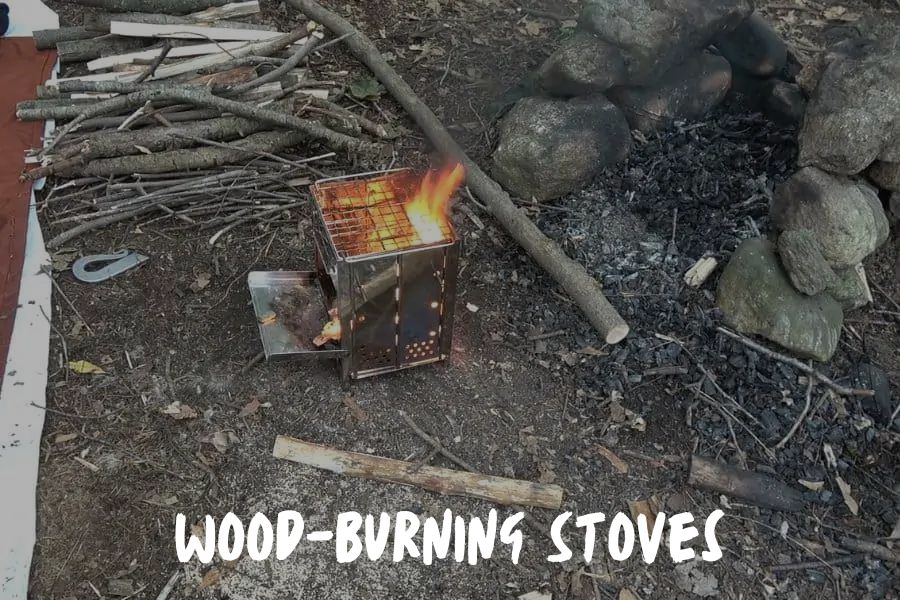
If you’re bringing a hot tent with you on your trip, you’ll be able to use a wood-burning stove inside it to keep warm on a cold night.
This type of stove (predictably) burns wood to keep the interior of the tent warm.
Because of this, there’s no need to bring a huge amount of fuel with you, since you’ll be able to gather wood at most campsites.
Hot tents are specifically treated to be fire resistant, so they’re safe to have a contained fire within them.
But always be careful that the flame doesn’t get too big!
Electric-Free Heating Alternatives
When you’re out on the trail it can be difficult to lug around the propane needed for the heating options above.
Let’s go over a few options you can use to heat up your tent that are fuel-free.
These options are especially great when you’re backpacking long distances and don’t want to carry around the extra weight.
Use Hot Water Bottles
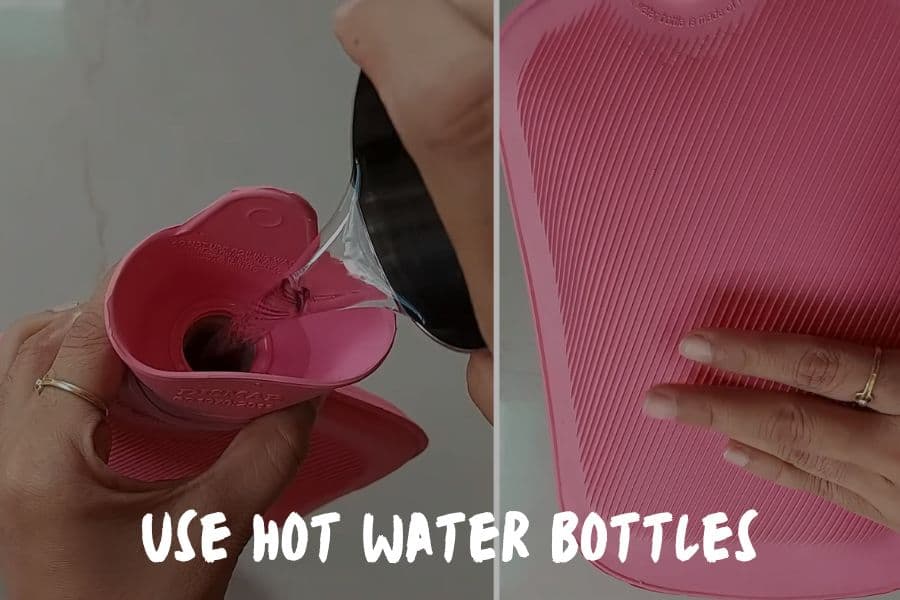
Hot water bottles can be a great option when you’re out at the campsite and need to stay warm.
This technique consists of filling insulated water bottles with warm water that you’ve boiled with your camping kitchen gear.
Once the hot water bottles are ready to go, you can place them almost anywhere!
I recommend putting them in the foot of your sleeping bag to keep your feet warm, or in the center of the tent to warm up the surrounding air.
In any case, it’s important to keep in mind that this is just a temporary solution.
Even when properly heated up, hot water bottles cool down fast, so they won’t keep you warm all night long.
Use A Heated Blanket
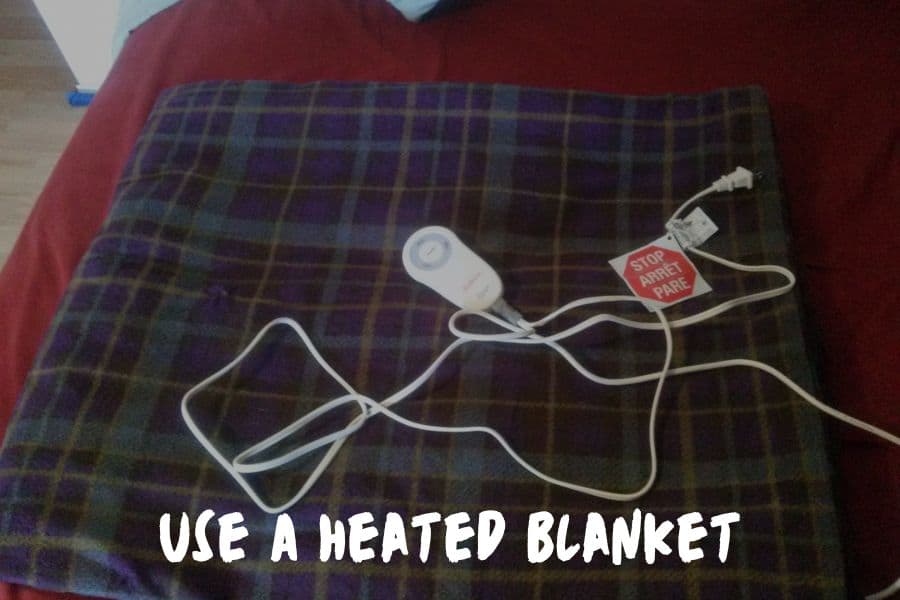
Heated blankets can be a great addition to any cold-weather camping trip.
These blankets have wiring running through them that gets warm at the press of a button and are usually battery-operated.
You can use them as an additional layer in your sleeping setup.
Heated blankets are best for car camping or campouts where you do not have to carry your supplies too far.
They can be bulky, and the highest quality ones can require a charge to operate effectively.
Use Non-Electric Heaters
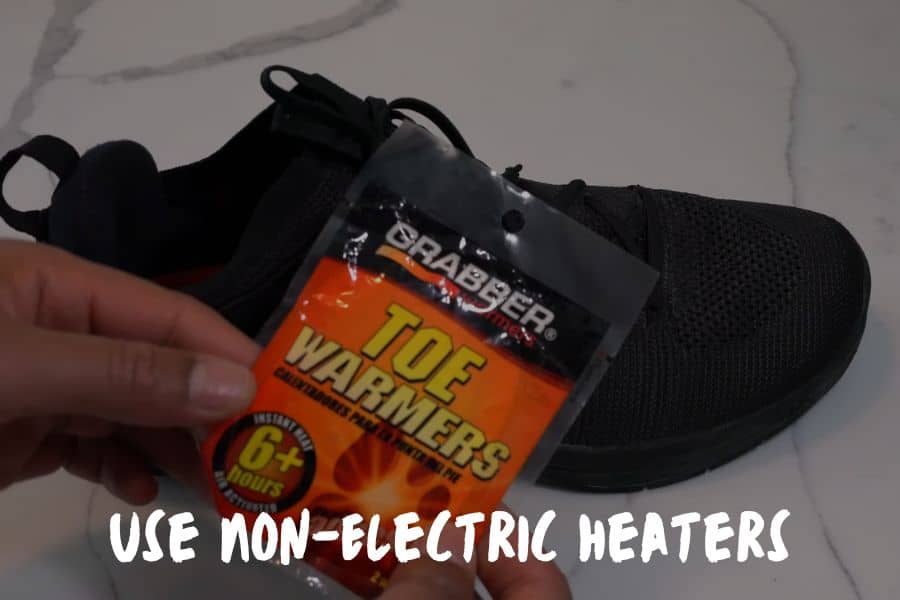
Non-electric heaters like hand and foot warming pads aren’t just for your gloves and shoes!
If you’re in a pinch, using a few of these heaters to help warm up your sleeping bag before you get in can be a great way to keep yourself warm through the night.
This is especially useful when your internal body heat is low, and you need some extra help warming up your bag without too much hassle.
Build A Campfire
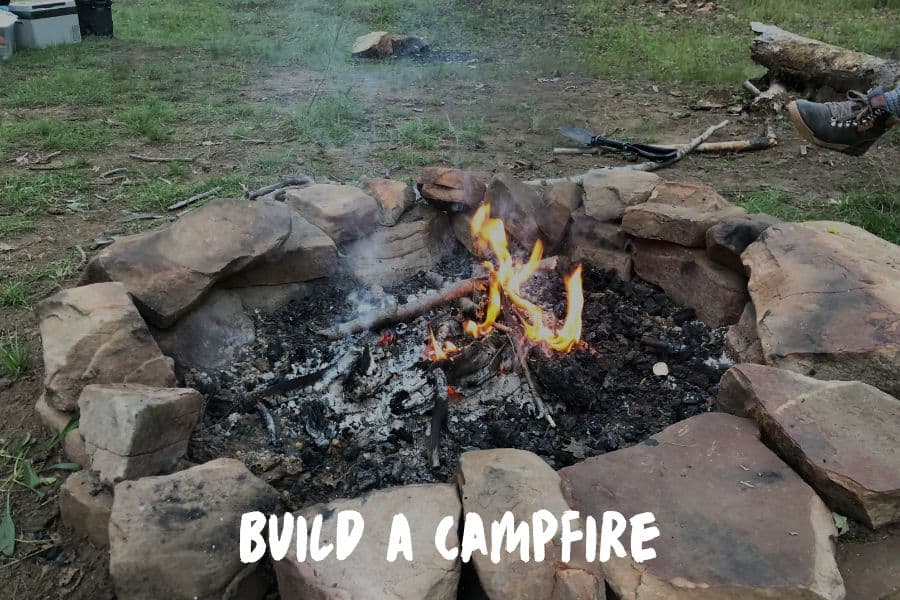
Building a fire is a great way to keep warm for a few reasons.
Sitting around the campfire raises your internal temperature, which will help you warm up the area around you with your body heat.
Second, setting up your tent close to a fire can help your tent get warm.
However, when setting up a tent near a fire, make sure that you set it up a safe distance away and keep the fire levels down.
You don’t want to risk your tent getting caught in the flames.
Also see: 7 Campfire Safety Tips: How to Stay Safe Around the Campfire
Use Leftover Coals
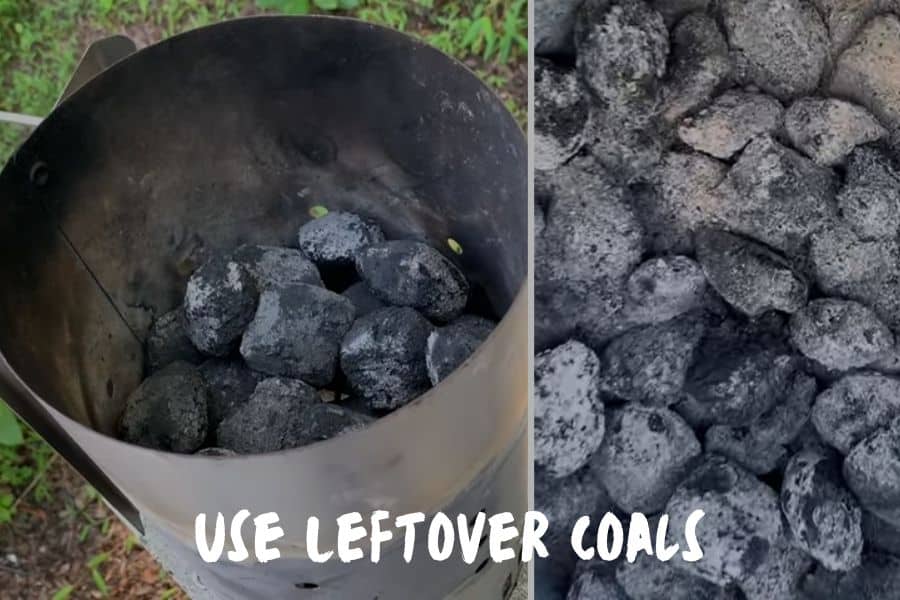
A more old-fashioned method, using leftover coals set up in a safe way can help keep your tent warm from below.
This method involves creating a fire, then putting it out and covering the still-hot coals with dirt or sand.
Once the coals are covered up, you set up your tent on top of the hot ground and use the heat that’s radiating up to heat your tent.
When using this method, it’s really important that all the coals are no longer active (no longer able to start fires).
Your tent is flammable, so you don’t want any sparks or potential flames underneath it.
Of course, you want to make sure they’re deep enough so that your tent bottom doesn’t catch on fire.
But you don’t want to go too deep either, as the heat might not reach your tent.
Really, this is a trial-and-error method, so you might not get it right the first time.
Bring Candle Lanterns
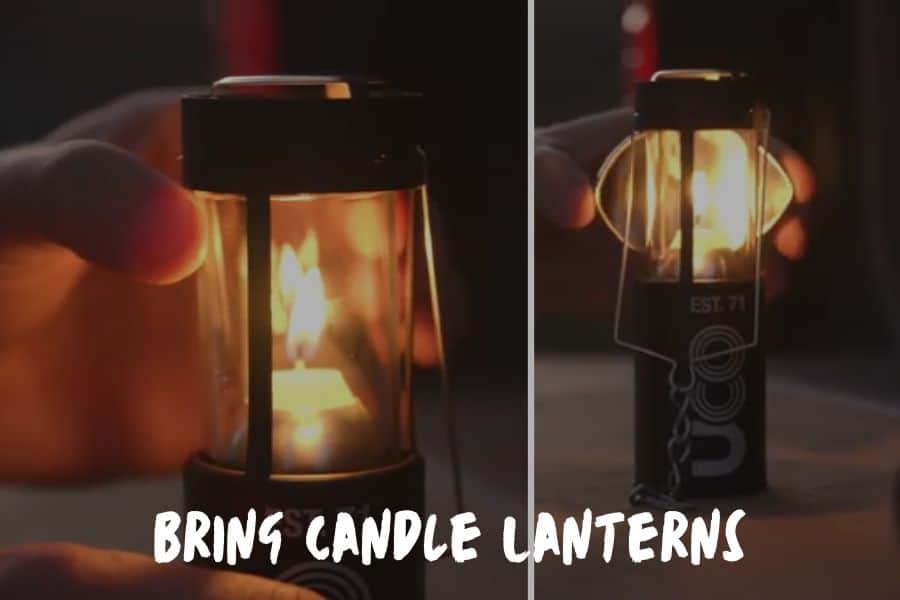
Don’t underestimate candles! You might not use them for cooking, but you can fill the lantern with them and use that for heating the tent.
Plus, there’s something so beautiful about the flickering flames.
But aside from looking good, candle lanterns do a decent job of keeping the tent warm for a few hours.
Candle lanterns use tea candles to heat up a larger container, which you can hang in your tent to add heat.
Because the candles are small and kept separate from one another, the fire risk for this strategy is fairly low.
And yes, they can be bulky, which is every camper’s nightmare.
But nowadays, you can find collapsible candle lanterns, which fold down flat for easy storage inside a backpack.
However, any time you’re bringing open flame into your tent there is an inherent risk.
I recommend you use this strategy when other strategies for staying warm are insufficient.
Additional Tips For Comfortable Cold Weather Camping
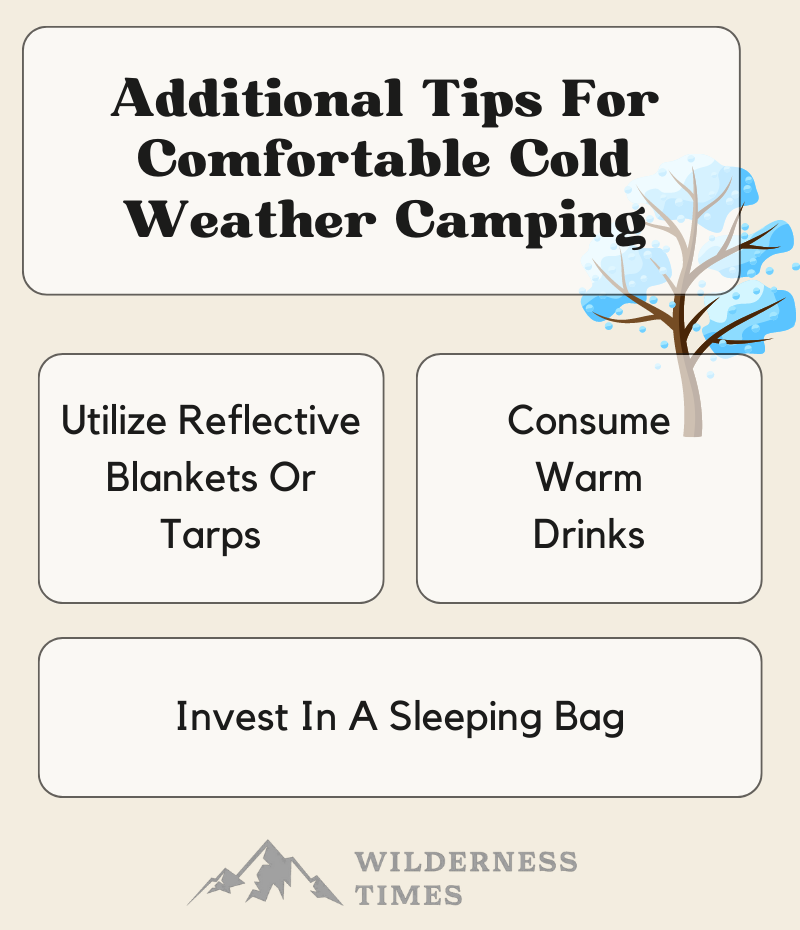
If you’ve tried one of the methods above, and you’re still feeling chilly, here are a few additional tips and tricks to keep your winter camping trip a good time.
Utilize Reflective Blankets Or Tarps
When in doubt, you can always use a reflective emergency blanket or a tarp to create another layer of insulation.
These materials are especially useful because they are common pieces of gear that you should bring with you on any campout or trek.
If you have a reflective blanket, you can lay it over your sleeping bag like an added blanket.
This additional layer will trap your body heat around you and work to keep you warm while you sleep.
You could also lay it out as a footprint and pitch the tent on top of it.
That way, the reflective blanket will protect the tent bottom from the cold ground underneath.
In comparison, when a tarp is pitched over your tent in cold weather, it creates another layer of insulating air over your sleeping area.
This can keep you even more toasty through the night.
Consume Warm Drinks
The water in our bodies works as a thermoregulator. We know that if we get too hot, we lose water through sweat.
Well, in colder weather, we don’t feel as thirsty as we would in warmer weather.
As a result, it’s easier to get dehydrated during winter. And you know what that means – a cooler body.
Staying hydrated and consuming warm drinks can be crucial steps in staying warm on a cold-weather trip.
You can drink anything from tea to hot Gatorade (trust me, it’s great!) on a cold night to bring up your internal body temperature and keep you warm from the inside out.
Invest In A Sleeping Bag
Your sleeping bag is one of your most important pieces of gear.
So, it’s worth it to invest a bit more cash on it – especially when it comes to keeping yourself warm.
When it comes to insulation options, goose-down is more pricey than synthetic insulation.
But it’ll keep you much warmer and is absolutely worth the price from a warmth perspective.
You also want to consider other features, such as shape, draft collar, zippers, and hoods.
All of these little features can improve the warmth of your sleeping bag.
I recommend a mummy design that protects your head and prevents warm air from escaping.
This is likely to come with a higher price tag as well, but you’ll thank yourself for spending the extra bucks.
FAQs
Are There Any Alternative Fuel Options Besides Propane, Wood, Or Liquid Fuel For Heating A Tent Without Electricity?
Yes! Although the main options for heating require the use of propane, wood, or liquid fuel, there are solar-powered “fuel” options on the market.
Campers like solar-powered fuel options because they require less fuel and can be used almost anywhere.
How Long Can Hot Water Bottles Or Heated Blankets Provide Warmth In A Tent Without Electricity?
Hot water bottles and heated blankets can keep you warm as you fall asleep, but won’t keep you warm for the entire night.
They are likely to last anywhere from 4 to 6 hours.
That being said, these strategies are important for getting your internal temperature up.
This will help you create enough body heat for the sleeping bag and tent.
You’ll find that once you get the interior of a tent warm in this way, it will take more than a few hours (or extreme conditions) for it to get cold again.
How Can I Effectively Distribute Heat Inside A Tent When Using Electric-Free Heating Methods?
Most double-walled tents will get and retain heat from the body heat of those sleeping inside of it.
Because of this, your priority should be getting yourself warm in your sleeping bag.
The warmer you can get yourself, the warmer your tent will be.
On an especially cold night, having privacy and space while sleeping can keep you colder than getting close to your camping partners.
If you’re hiking with a group, it can be worth it to squeeze more people into the tents than usual to increase body heat and the overall temperature of the tent.
Are There Any Specific Considerations For Heating A Larger Tent Or A Family-Sized Tent Without Electricity?
The larger the tent, the more difficult it will be to warm the entirety of the interior structure.
If you’re using a larger tent, it will take more effort to get it completely warm, which will require planning ahead to bring the right gear and equipment.
I recommend that you bring smaller tents when camping in cold weather – even if you have to bring more of them.
What Are Some Common Mistakes To Avoid When Attempting To Heat A Tent Without Electricity?
The most common mistakes made when someone is trying to heat a tent without electricity are usually all safety-related.
When you’re heating up your tent, make sure that you follow the safety advice we detailed above.
Having proper ventilation, keeping your tent away from open flames, and keeping heated items wrapped in flame-resistant fabric will help keep you safe.
Final Thoughts
It can get cold out there! Any combination of the above strategies will help keep you safe and warm during your next winter campout.
So, even though you may not have electricity, you can still have a cozy space while you’re enjoying nature.
Happy warm camping!
More on Cold Weather Camping:


